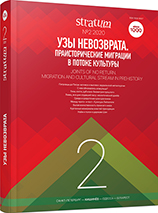Миграции в неолите Зауралья в свете радиоуглеродной хронологии
Neolithic Trans-Ural Migrations in the Light of Radiocarbon Chronology
Author(s): Alexander F. Shorin, Anastasia A. ShorinaSubject(s): History, Archaeology, Migration Studies
Published by: Издательский дом Stratum, Университет «Высшая антропологическая школа»
Keywords: North, Middle and South Trans-Ural; Tobol-Ishim interfluvial plain; Neolithic; absolute chronology; Neolithization process; migrations;
Summary/Abstract: The author studies the chronology of the Neolithic in the three Trans-Ural regions: the Middle and the South, the North, and the Tobol-Ishim interfluvial plain. The beginning of the Neolithic period in the region is dated as the middle — the third quarter of the 7th millennium BC. In the Middle and the South Trans-Ural it may be associated with the Koshkino and the Kozlov cultures. In the last quarter of the 6th — the first quarter of the 5th millennium BC, the Koshkino and the Kozlov culture complexes gradually transformed into the Boborykino-Basjyanovskaya and the Poludenskaya ones. Those new cultures characterized the Late Neolithic period in the region, which, in the end of the third — fourth quarter of the 5th millennium BC, gave way to the Eneolithic. The idea of separation of the early Boborykino stage in the Tyumen Trans-Ural is ill founded, since the early dates for the Boborykino culture settlement Jurtobor 3, which in that framework preceded Mergen 6 settlement, are not conclusive. The author also used the absolute dates to raise questions concerning the region’s Neolithization, including a better understanding of the role of migrations in the process. It is concluded that using archaeological methods alone will hardly make it possible to identify with certainty the specific zone from which the ceramic production — an important component of the process of Neolithization of the Northern regions of Eurasia, unfamiliar with the producing economy — penetrated into the region, or fully understand the mechanisms for the transfer of the new traditions (through migration of relatively large groups of foreign population, infiltration of smaller populations, or exogamic marriages with neighboring populations).
Journal: Stratum plus. Археология и культурная антропология
- Issue Year: 2020
- Issue No: 2
- Page Range: 31-56
- Page Count: 26
- Language: Russian
- Content File-PDF

